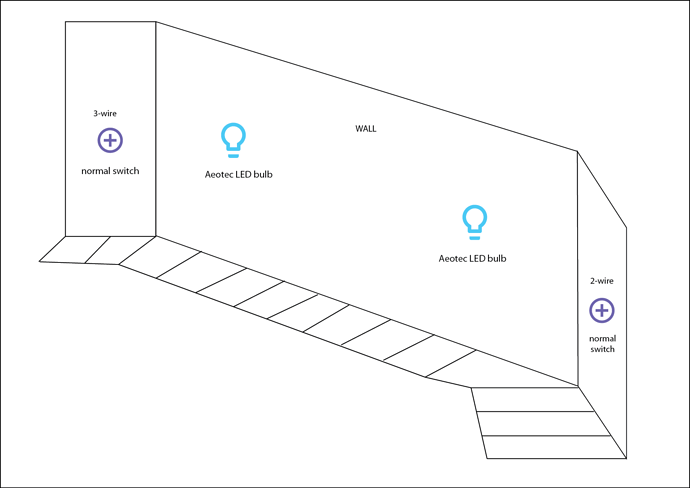Oh, and as @anon36505037 mentioned, it’s not going to be helpful to have the micro relay controlling the current to the bulb. Your other idea of the battery operated switch is better. I also agree with him that since you’re talking about a bulb in clear air, it should cover the full range of the staircase just fine. So use battery operated switches to control the zwave bulb that is central.
Now you have to figure out what’s going to catch that signal at the bottom of the stairway and get it into the next room. There are a couple of other of options there.
If you’re just looking for a repeater and there isn’t a receptacle that you can plug something into, I could see your idea of putting a relay on the bottom switch but not actually using it, just letting it repeat and putting a battery operated switch near it to control the light.
That should work pretty well. You’d be using a fairly expensive device, the Micro, at the bottom of the stairwell, solely to act as a repeater into that lower room, but if you’re OK with that cost, technically you should be fine. The lightbulb would bounce signal to the relay that you aren’t using for anything else except a repeater. And the relay would bounce it into the lower room.
But you do end up with four devices, then: the lightbulb in the middle of the stairwell, battery operated switches at both the top and the bottom to control that light, and a relay at the bottom inside the wall to act as a repeater.
This is where we get into one of those “all home automation is local” situations. The relay will act as a repeater, that’s true. But if your wall has that foil backed insulation or is made of cement it may be really hard to get signal to a device inside the wall.
You probably already know this, but battery operated devices generally do not repeat. So the question would be whether instead there’s a place to put a pocket socket that could still catch signal from the lightbulb.
So as far as the micro goes, it’s intended to act as a repeater, but if you’re already having problems getting signal through the walls there’s no question that the device inside the wall may have more problems that a device that’s just a plug-in.
You may just have to try it and see.
